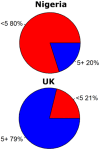Global occurrence and emission of rotaviruses to surface waters
- PMID: 25984911
- PMCID: PMC4493472
- DOI: 10.3390/pathogens4020229
Global occurrence and emission of rotaviruses to surface waters
Erratum in
-
Correction: Global Occurrence and Emission of Rotaviruses to Surface Waters. Pathogens 2015, 4, 229-255.Pathogens. 2016 Mar 1;5(1):26. doi: 10.3390/pathogens5010026. Pathogens. 2016. PMID: 26938565 Free PMC article.
Abstract
Group A rotaviruses (RV) are the major cause of acute gastroenteritis in infants and young children globally. Waterborne transmission of RV and the presence of RV in water sources are of major public health importance. In this paper, we present the Global Waterborne Pathogen model for RV (GloWPa-Rota model) to estimate the global distribution of RV emissions to surface water. To our knowledge, this is the first model to do so. We review the literature to estimate three RV specific variables for the model: incidence, excretion rate and removal during wastewater treatment. We estimate total global RV emissions to be 2 × 1018 viral particles/grid/year, of which 87% is produced by the urban population. Hotspot regions with high RV emissions are urban areas in densely populated parts of the world, such as Bangladesh and Nigeria, while low emissions are found in rural areas in North Russia and the Australian desert. Even for industrialized regions with high population density and without tertiary treatment, such as the UK, substantial emissions are estimated. Modeling exercises like the one presented in this paper provide unique opportunities to further study these emissions to surface water, their sources and scenarios for improved management.
Keywords: contamination; emission; feces; global; modeling; rotavirus; sanitation; sewage.
Figures



Similar articles
-
Present and Future Human Emissions of Rotavirus and Escherichia coli to Uganda's Surface Waters.J Environ Qual. 2018 Sep;47(5):1130-1138. doi: 10.2134/jeq2017.12.0497. J Environ Qual. 2018. PMID: 30272777
-
Impacts of population growth, urbanisation and sanitation changes on global human Cryptosporidium emissions to surface water.Int J Hyg Environ Health. 2016 Oct;219(7 Pt A):599-605. doi: 10.1016/j.ijheh.2016.06.005. Epub 2016 Jun 15. Int J Hyg Environ Health. 2016. PMID: 27358259
-
Epidemiological significance of the occurrence and persistence of rotaviruses in water and sewage: a critical review and proposal for routine microbiological monitoring.Environ Sci Process Impacts. 2022 Mar 23;24(3):380-399. doi: 10.1039/d1em00435b. Environ Sci Process Impacts. 2022. PMID: 35174845 Review.
-
Detection and genotyping of group A rotaviruses isolated from sewage samples in Monastir, Tunisia between April 2007 and April 2010.J Appl Microbiol. 2015 Nov;119(5):1443-53. doi: 10.1111/jam.12920. Epub 2015 Sep 24. J Appl Microbiol. 2015. PMID: 26248601
-
[Rotavirus gastroenteritis and its vaccination].Zhonghua Yu Fang Yi Xue Za Zhi. 2020 Jul 6;54(7):787-792. doi: 10.3760/cma.j.cn112150-20190816-00653. Zhonghua Yu Fang Yi Xue Za Zhi. 2020. PMID: 32842304 Review. Chinese.
Cited by
-
Molecular detection and genotyping of group A rotavirus in two wastewater treatment plants, Iran.Braz J Microbiol. 2020 Mar;51(1):197-203. doi: 10.1007/s42770-019-00131-0. Epub 2019 Aug 12. Braz J Microbiol. 2020. PMID: 31407291 Free PMC article.
-
Exploring Survey-Based Water, Sanitation, and Animal Associations With Enteric Pathogen Carriage: Comparing Results in a Cohort of Cases With Moderate-to-Severe Diarrhea to Those in Controls in the Vaccine Impact on Diarrhea in Africa (VIDA) Study, 2015-2018.Clin Infect Dis. 2023 Apr 19;76(76 Suppl1):S140-S152. doi: 10.1093/cid/ciac918. Clin Infect Dis. 2023. PMID: 37074442 Free PMC article.
-
A systematic review and meta-analysis of pathogen reduction in onsite sanitation systems.Water Res X. 2023 Feb 21;18:100171. doi: 10.1016/j.wroa.2023.100171. eCollection 2023 Jan 1. Water Res X. 2023. PMID: 37250291 Free PMC article. Review.
-
Molecular surveillance of human rotaviruses in drinking water and investigation of the efficiency of their removal in Isfahan water treatment plant.Environ Monit Assess. 2019 Nov 19;191(12):759. doi: 10.1007/s10661-019-7834-0. Environ Monit Assess. 2019. PMID: 31741059
-
Identification of enteroviruses along Lake Victoria shoreline - a potential indicator of sewage pollution.Access Microbiol. 2022 Apr 25;4(4):000334. doi: 10.1099/acmi.0.000334. eCollection 2022. Access Microbiol. 2022. PMID: 35812714 Free PMC article.
References
-
- Moe C.L., Rheingans R.D. Global challenges in water, sanitation and health. J. Water Health. 2006;4:41. - PubMed
-
- WHO . Progress on Drinking-Water and Sanitation–2012 Update" Launched on 6 March 2012. World Health Organization; Geneva, Switzerland: 2012.
-
- WHO/UNICEF . Joint Monitoring Programme (JMP) for Water Supply and Sanitation, Progress on Sanitation and Drinking-Water, 2013 Update. WHO/UNICEF; Geneva, Switzerland: 2013.
LinkOut - more resources
Full Text Sources
Other Literature Sources

